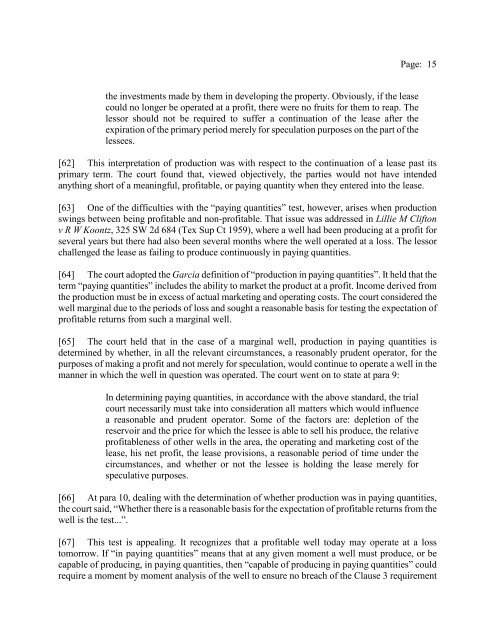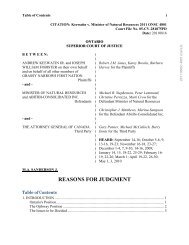Omers Energy Inc. v. Alberta (Energy Resources Conservation Board)
Omers Energy Inc. v. Alberta (Energy Resources Conservation Board)
Omers Energy Inc. v. Alberta (Energy Resources Conservation Board)
- No tags were found...
You also want an ePaper? Increase the reach of your titles
YUMPU automatically turns print PDFs into web optimized ePapers that Google loves.
Page: 15the investments made by them in developing the property. Obviously, if the leasecould no longer be operated at a profit, there were no fruits for them to reap. Thelessor should not be required to suffer a continuation of the lease after theexpiration of the primary period merely for speculation purposes on the part of thelessees.[62] This interpretation of production was with respect to the continuation of a lease past itsprimary term. The court found that, viewed objectively, the parties would not have intendedanything short of a meaningful, profitable, or paying quantity when they entered into the lease.[63] One of the difficulties with the “paying quantities” test, however, arises when productionswings between being profitable and non-profitable. That issue was addressed in Lillie M Cliftonv R W Koontz, 325 SW 2d 684 (Tex Sup Ct 1959), where a well had been producing at a profit forseveral years but there had also been several months where the well operated at a loss. The lessorchallenged the lease as failing to produce continuously in paying quantities.[64] The court adopted the Garcia definition of “production in paying quantities”. It held that theterm “paying quantities” includes the ability to market the product at a profit. <strong>Inc</strong>ome derived fromthe production must be in excess of actual marketing and operating costs. The court considered thewell marginal due to the periods of loss and sought a reasonable basis for testing the expectation ofprofitable returns from such a marginal well.[65] The court held that in the case of a marginal well, production in paying quantities isdetermined by whether, in all the relevant circumstances, a reasonably prudent operator, for thepurposes of making a profit and not merely for speculation, would continue to operate a well in themanner in which the well in question was operated. The court went on to state at para 9:In determining paying quantities, in accordance with the above standard, the trialcourt necessarily must take into consideration all matters which would influencea reasonable and prudent operator. Some of the factors are: depletion of thereservoir and the price for which the lessee is able to sell his produce, the relativeprofitableness of other wells in the area, the operating and marketing cost of thelease, his net profit, the lease provisions, a reasonable period of time under thecircumstances, and whether or not the lessee is holding the lease merely forspeculative purposes.[66] At para 10, dealing with the determination of whether production was in paying quantities,the court said, “Whether there is a reasonable basis for the expectation of profitable returns from thewell is the test...”.[67] This test is appealing. It recognizes that a profitable well today may operate at a losstomorrow. If “in paying quantities” means that at any given moment a well must produce, or becapable of producing, in paying quantities, then “capable of producing in paying quantities” couldrequire a moment by moment analysis of the well to ensure no breach of the Clause 3 requirement
















